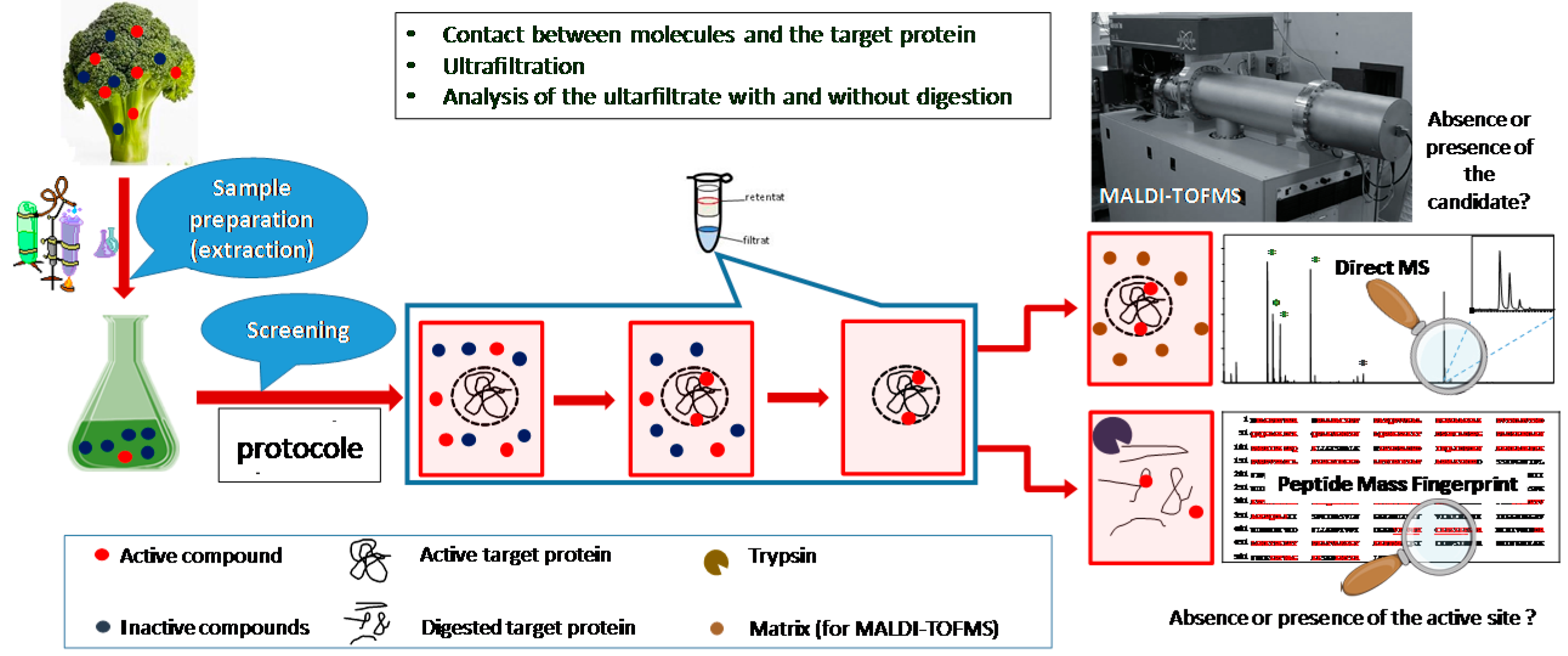Diagnosis of Biological Activities by Mass Spectrometry †
Abstract
:1. Introduction
2. Monitoring and Evaluation of Disturbances Occurring in the Cell Cycles and Pathophysiological Events
3. Fishing Active Metabolites from Plant Extracts
4. Highlighting Biomarkers in Tissues
Author Contributions
Funding
Conflicts of Interest
References
- Yu, H.; Bonetti, J.; Gaucher, C.; Fries, I.; Vernex-Loset, L.; Leroy, P.; Chaimbault, P. Higher-energy Collision Dissociation for the quantification by liquid chromatography-tandem ion trap mass spectrometry of nitric oxide metabolites coming from S-nitrosoglutathione in an in vitro model of intestinal barrier. Rapid Commun. Mass Spectrom. 2019, 33, 1–11. [Google Scholar] [CrossRef] [PubMed]
- Hannewald, P.; Maunit, B.; Muller, J.-F. Tubulin-binding drug screening by MALDI-TOFMS. Anal. Chem. 2006, 78, 4390–4397. [Google Scholar] [CrossRef] [PubMed]
- Efe, E.Y.; Mazumder, A.; Lee, J.-Y.; Gaigneaux, A.; Radogna, F.; Nasim, M.J.; Christov, C.; Jacob, C.; Kim, K.-W.; Dicato, M.; et al. Tubulin-binding anticancer polysulfides induce cell death via mitotic arrest and autophagic interference in colorectal cancer. Cancer Lett. 2017, 410, 139–157. [Google Scholar] [CrossRef]
- Hannewald, P.; Maunit, B.; Muller, J.-F. Screening of DHFR-binding drugs by MALDI-TOFMS. Anal. Bioanal. Chem. 2008, 392, 1335–1344. [Google Scholar] [CrossRef] [PubMed]
- Sibille, E.; Bana, E.; Chaouni, W.; Diederich, M.; Bagrel, D.; Chaimbault, P. Development of a MALDI-MS screening test to evidence reversible and irreversible inhibitors of CDC25 phosphatases. Anal. Biochem. 2012, 430, 83–91. [Google Scholar] [CrossRef] [PubMed]
- Becker, L.; Poutaraud, A.; Hamm, G.; Muller, J.-F.; Merdinoglu, D.; Carré, V.; Chaimbault, P. Metabolic study of grapevine leaves infected by downy mildew using negative ion electrospray—Fourier transform ion cyclotron resonance mass spectrometry. Anal. Chim. Acta 2013, 79, 544–551. [Google Scholar] [CrossRef] [PubMed]
- Becker, L.; Carré, V.; Poutaraud, A.; Merdinoglu, D.; Chaimbault, P. MALDI mass spectrometry imaging for the simultaneous location of resveratrol, pterostilbene and viniferins on grapevine leaves. Molecules 2014, 19, 10587–10600. [Google Scholar] [CrossRef] [PubMed]
- Becker, L.; Bellow, S.; Carré, V.; Latouche, G.; Poutaraud, A.; Merdinoglu, D.; Brown, S.; Cerovic, Z.; Chaimbault, P. Correlative analysis of fluorescent phytoalexins by mass spectrometry imaging and fluorescence microscopy in grapevine leaves. Anal. Chem. 2017, 89, 7099–7106. [Google Scholar] [CrossRef] [PubMed]


© 2019 by the authors. Licensee MDPI, Basel, Switzerland. This article is an open access article distributed under the terms and conditions of the Creative Commons Attribution (CC BY) license (https://creativecommons.org/licenses/by/4.0/).
Share and Cite
Carré, V.; Leroy, P.; Chaimbault, P. Diagnosis of Biological Activities by Mass Spectrometry. Proceedings 2019, 11, 36. https://doi.org/10.3390/proceedings2019011036
Carré V, Leroy P, Chaimbault P. Diagnosis of Biological Activities by Mass Spectrometry. Proceedings. 2019; 11(1):36. https://doi.org/10.3390/proceedings2019011036
Chicago/Turabian StyleCarré, Vincent, Pierre Leroy, and Patrick Chaimbault. 2019. "Diagnosis of Biological Activities by Mass Spectrometry" Proceedings 11, no. 1: 36. https://doi.org/10.3390/proceedings2019011036
APA StyleCarré, V., Leroy, P., & Chaimbault, P. (2019). Diagnosis of Biological Activities by Mass Spectrometry. Proceedings, 11(1), 36. https://doi.org/10.3390/proceedings2019011036





